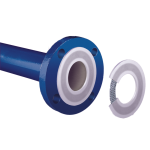ePTFE is porous when uncompressed, apply several tonnes of force in a flange and it is no longer porous so gets to the same density as virgin PTFE, yet has more strength from the now much more structured material. The compression of ePTFE is no way linear, they compress very easily and become dense very quickly. If for some reason you cannot put enough force into the material (plastic flanges, glass lined steel), gaskets exist with pre-compressed dense sections to act as permeation barriers (Gore Universal Pipe Gasket and/or other PTFE envelope types) or add stress peaks/ridges to gain more densification in certain spots ("stress saver" types)
Now the following analogy isn't 100% accurate but is close enough, any material/polymer scientists please look away for a minute

Imagine you are doing a tensile test on a steel bar, pull it until it breaks say at 1500kg of force. During this test it stretches 60%.
Now get another bar twice as big, stretch it 50%. (lets say it takes roughly 2500kg of force to do) Cut out a smaller bar from the stretched deformed section the same dimensions as the first bar. i.e. half the size
Now this third expanded bar with the same dimensions of the first bar and the same material just prestressed, do a tensile test on it... what will you see ?
It basically won't change dimension until you give more than 1250kg of force on it, it will still break at around 1500kg but with only a ~10% deformation.
Now ePTFE is the same(ish) principle, the "fibres" of the PTFE have been prestressed so require more force to now stretch them. Now we can prestress/expand them in different dimensions, x,y or even z. In good ePTFE gasket sheets they are prestressed in both the x and y direction but not the z (z being compression direction). So they are easy to deform in the z direction and hard to deform in the x-y direction. Now, if you deform the z direction so much that you reach a density were to deform it any more in this direction you must also change the x-y dimensions (we call this the ultimate density) it becomes much harder to deform the material. So for a sheet gasket material you want to be able to get quickly down to this ultimate density during installation load then during service when the heat comes in you want it to deform the gasket in the z-direction as little as possible. The pre-stressed "fibres" now hinder the ability to deform in the x-y direction preventing z-direction deformation too. This is how we add creep resistance.
Other sheet PTFEs do it differently by adding fillers which basically increases the friction inside the material which hinders the x-y deformation...guess which way works better

If you want more details on ePTFE gaskets.. head to
www.gore.com/sealants or
https://teadit.com/us/categoria/eptfe-products/ both make good ePTFE products. Beware of bad ePTFE's
Disclaimer, as I've said before on this forum I work for Gore.


